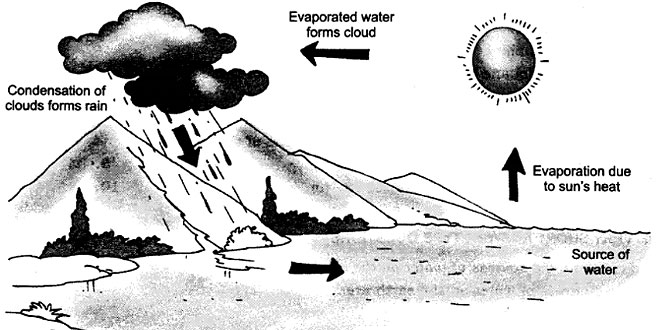Water: NCERT 7th Class CBSE Social Science – Geography
Question: Answer the following questions briefly
- What is precipitation?
- What is water cycle?
- What are the factors affecting the height of the waves?
- Which factors affect the movement of ocean water?
- What are tides and how are they caused?
- What are ocean currents?
Answer:
- Falling of moisture in the form of rainfall, snow, fog, sleet and hailstone is termed as precipitation.
- The water cycle is the process by which water continually changes its form and circulates between oceans, atmosphere and land.
- Winds, earthquakes, volcanic eruption or under water landslides are the factors affecting the height of the waves. The stronger the wind blows, the bigger the wave becomes.
- Temperature, winds, gravitational pull of the sun, the earth and the moon; warm and cold currents are the factors that affect the movement of ocean water.
- Tides are the rhythmic rise and fall of ocean water that occur twice in a day. The strong gravitational pull exerted by the sun and the moon on the earth’s surface causes the tides.
- Ocean currents are streams of water flowing constantly on the ocean surface in definite directions.
Question: Give reasons:
- Ocean water is salty.
- The quality of water is deteriorating.
Answer:
- The water of the oceans is salty as it contains large amount of dissolved salts.
- Water is being used injudiciously. Whatever potable water is available, its quality is not good. It is because industrial effluents and untreated water of industries get mixed into streams and rivers. Sewage water also gets mixed into these water bodies. As a result, the quality of water is deteriorating day by day.
Question: Tick the correct answer
- The process by which water continually changes its form and circulates between oceans, atmosphere and land
(i) Water cycle (ii) Tides (iii) Ocean currents. - Generally the warm ocean currents originate near
(i) Poles (ii) Equator (iii) None of these. - The rhythmic rise and fall of ocean water twice in a day is called
(i) Tide (ii) Ocean current (iii) Wave
Answer: (a) – (i), (b) – (ii), (c) – (i)
Question: What is terrarium?
Answer: It is an artificial enclosure for keeping small house plants.
Water – 7th Geography Question: Which type of water do the ocean bodies and the seas contain?
Answer: They contain salty water.
Question: What do you mean by salinity?
Answer: Salinity is the amount of salt in grams present in 1000 grams of water.
Question: What is the average salinity of the oceans?
Answer: The average salinity of the oceans is 35 parts per thousand.
Water – 7th Geography Question: What is the salinity of Dead sea?
Answer: The salinity of Dead sea is 45 parts per thousand.
Question: Why do swimmers float in Dead Sea?
Answer: Swimmers float in Dead sea because the increased salt content makes it dense.
Question: What is the significance of World Water Day?
Answer: On the occasion of World Water Day (22nd March) the need to conserve water is reinforced in different ways.
Question: What is Tsunami?
Answer: Tsunami is a Japanese word that means ‘Barbour Waves’ as the harbors get destroyed whenever there is Tsunami.
Question: What happens during high tide?
Answer: During high tide waves rise high and water covers much of the shore.
Question: What happens during low tide?
Answer: During low tide water falls to its lowest level and recedes from the shore.
Question: How are tides caused?
Answer: The strong gravitational pull exerted by the sun and the moon on the earth’s surface causes tides.
Question: Name one warm current and one cold current.
Answer:
Warm current: The Gulf Stream
Cold current: The Labrador Ocean current
Question: What happened to the Indira point during the tsunami of 2004?
Answer: It got submerged.
Question: How are spring and neap tides formed.
Answer: During the full moon and new moon days, the sun, the moon and the earth are in the same line and the tides are highest. These tides are called spring tides. But when the moon is in its first and last quarter, the ocean waters get drawn in diagonally opposite directions by the gravitational pull of sun and earth resulting in low tides. These tides are called neap tides.
Question: How are high tides important?
Answer: High tides are important for various reasons:
- They help in navigation
- The raise the water level close to the shores. This helps the ships to arrive at the harbor more easily.
- The high tides also help in fishing. Many more fish come closer to the shore during the high. This enables the fisherman to get a plentiful catch.
- The rise and fall of water due to tides is being used to generate electricity in some places.
Question: What are waves? Write a short note on it
Answer: Waves are the rise and fall of the water on the surface of the ocean. Waves are formed when winds scrape across the ocean surface. The stronger the wind blows, the bigger the wave becomes. During the storm, the winds blow at very high speed and therefore huge waves are formed. These waves are very strong, hence very destruction. They may cause huge devastation.
Question: Write a brief note on Tsunami.
Answer: Tsunami is a Japanese word that means ‘harbor waves’ as the harbors get destroyed whenever there is tsunami. An earthquake, a volcanic eruption or underwater landslides can shift large amounts of ocean water. As a result tsunami occurs which may be as high as 15 m. The tsunami of 2004 is still in our mind. It caused huge death and destruction in the coastal areas of India. The Indira point in the Andaman and Nicobar Islands got submerged after the tsunami.
Question: Write a note on the importance of water.
Answer: Water is life. Without water, we can not think of life. Its scarcity may create numerous problems but its absence would definitely lead to non-existence of all the living beings on the earth. It is a precious resource of the nature. We drink water whenever we feel thirsty. We use water in numerous activities such as washing clothes, cleaning house floors, watering garden etc. Industries also need water for their functioning. Thus, water is very essential and therefore we must conserve it. Our careless use of water has created several problems. Whatever water is there, it is not of good quality. We should think about the ways of its conservation for our own sake.
Water – 7th Geography Question: Explain water cycle with a neat and labelled diagram.
Answer: The sun’s heat causes evaporation of water, flowing down to stream or drains into water vapour. When the water vapour cools down, it condenses and forms clouds. These clouds, when become too heavy to float, start falling on the land or sea in the form of rain, snow or sleet. Thus, the process by which water continuously changes its form and circulates between oceans, atmosphere and land is known as the water cycle.

Question: Give an account of ocean currents.
Answer: Ocean currents are streams of water flowing constantly on the ocean surface in definite directions. The ocean currents may be warm or cold. The warm ocean currents originate near the equator and move towards the poles. The cold current
carry water from polar or higher latitudes to tropical or lower latitudes. For example the Labrador Ocean current is cold current while the Gulf Stream is a warm current. The ocean current influence the temperature conditions of the area.
Warm currents bring about warm temperature over land surface. The areas where the warm and cold currents meet provide the best fishing grounds of the world. For example seas around Japan and the eastern coast of North America. The areas where a warm and cold current meet also experience foggy weather and therefore navigation becomes difficult.
Water – 7th Geography Question: How do we classify ocean movements? Explain.
Answer: Ocean movements can be classified into waves, tides and currents.
- When the water on the surface of the ocean rises and falls alternately, they are called waves. Waves are formed when winds scrape across the ocean surface. The stronger the wind blows, the bigger the wave becomes.
- The rhythmic rise and fall of ocean water twice in a day is known as a tide. Tides may be high or low. It is high tide when water covers much of the shore by rising to its highest level. It is low tide when water falls to its lowest level and recedes from the shore. Tides are caused due to the strong gravitational pull exerted by the sun and moon on the earth’s surface. High tides help in navigation and fishing. The rise and fall of water due to tides is being used to generate electricity in some places.
- Ocean currents. These are streams of water flowing constantly on the ocean surface in definite directions. The ocean currents may be warm such as the Gulf Stream and cold such as the Labrador Ocean current. The areas where the warm and cold currents meet provide the best fishing ground of the world. For example, seas around Japan and the eastern Coast of North America.
 Class Notes NCERT Solutions for CBSE Students
Class Notes NCERT Solutions for CBSE Students


